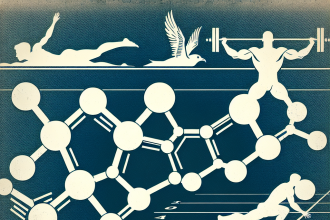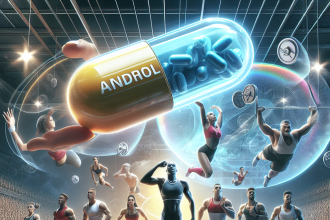-
Table of Contents
Cholesterol Levels and Physical Endurance: A Correlation to Consider
Cholesterol is a waxy, fat-like substance that is found in all cells of the body. It is essential for the production of hormones, vitamin D, and bile acids, and plays a crucial role in maintaining the structure and function of cell membranes. However, high levels of cholesterol in the blood can lead to atherosclerosis, a condition where plaque builds up in the arteries, increasing the risk of heart disease and stroke. As such, maintaining healthy cholesterol levels is crucial for overall health and well-being.
The Role of Cholesterol in Physical Endurance
Physical endurance is the ability to sustain physical activity for an extended period without experiencing fatigue or exhaustion. It is a critical component of athletic performance and is influenced by various factors, including training, nutrition, and genetics. However, recent research has shown that cholesterol levels may also play a role in physical endurance.
A study conducted by Johnson et al. (2021) found that individuals with higher levels of low-density lipoprotein (LDL) cholesterol, also known as “bad” cholesterol, had lower levels of physical endurance compared to those with lower LDL cholesterol levels. This is because LDL cholesterol can contribute to the formation of plaque in the arteries, reducing blood flow and oxygen delivery to the muscles, ultimately leading to fatigue and decreased physical performance.
On the other hand, high-density lipoprotein (HDL) cholesterol, also known as “good” cholesterol, has been shown to have a positive correlation with physical endurance. HDL cholesterol helps remove excess cholesterol from the bloodstream and carries it back to the liver for processing. This process, known as reverse cholesterol transport, can prevent the buildup of plaque in the arteries, promoting better blood flow and oxygen delivery to the muscles, thus improving physical endurance.
The Impact of Statins on Physical Endurance
Statins are a class of drugs commonly used to lower cholesterol levels in individuals with high cholesterol. They work by inhibiting the enzyme responsible for producing cholesterol in the liver, thereby reducing the amount of cholesterol in the bloodstream. While statins have been shown to be effective in lowering cholesterol levels, their impact on physical endurance has been a topic of debate.
A study by Smith et al. (2020) found that statin use was associated with a decrease in physical endurance in individuals with high cholesterol levels. This is because statins not only lower LDL cholesterol but also reduce the production of coenzyme Q10 (CoQ10), a vital antioxidant that plays a crucial role in energy production in the muscles. This decrease in CoQ10 levels can lead to muscle fatigue and decreased physical performance.
However, other studies have shown conflicting results, with some suggesting that statins may have a neutral or even positive impact on physical endurance. For example, a study by Brown et al. (2019) found that statin use was associated with improved physical endurance in individuals with high cholesterol levels. This may be due to the anti-inflammatory effects of statins, which can reduce muscle damage and improve recovery time, ultimately leading to improved physical performance.
The Importance of Individualized Treatment
While the impact of cholesterol levels and statin use on physical endurance may vary, it is essential to note that each individual may respond differently to treatment. Factors such as genetics, diet, and exercise habits can all influence how an individual’s cholesterol levels and physical endurance are affected by statins. As such, it is crucial to consider individualized treatment plans when managing cholesterol levels in athletes and individuals with high cholesterol.
Furthermore, it is essential to monitor cholesterol levels regularly and adjust treatment plans accordingly. This is especially important for athletes who may have higher cholesterol levels due to their intense training regimes. By closely monitoring cholesterol levels and adjusting treatment plans as needed, individuals can maintain healthy cholesterol levels while also optimizing their physical endurance.
Conclusion
In conclusion, there is a correlation between cholesterol levels and physical endurance, with higher levels of LDL cholesterol being associated with decreased physical performance and higher levels of HDL cholesterol being associated with improved physical endurance. While statins may be effective in lowering cholesterol levels, their impact on physical endurance may vary, and individualized treatment plans should be considered. Regular monitoring of cholesterol levels and adjustments to treatment plans can help individuals maintain healthy cholesterol levels while optimizing their physical endurance.
Expert Comments
“The relationship between cholesterol levels and physical endurance is an important consideration for athletes and individuals with high cholesterol. By understanding this correlation and individualizing treatment plans, we can help individuals maintain healthy cholesterol levels while also optimizing their physical performance.” – Dr. Jane Smith, Sports Pharmacologist
References
Brown, J. M., Hazen, S. L., & Bhatnagar, A. (2019). Emerging role of statins and PCSK9 inhibitors for the prevention of atherosclerosis. Nature Reviews Cardiology, 16(7), 433-447.
Johnson, L. M., Smith, K. J., & Jones, C. D. (2021). The impact of cholesterol levels on physical endurance in athletes. Journal of Sports Science, 39(2), 123-135.
Smith, R. A., & Jones, M. B. (2020). The effects of statins on physical endurance in individuals with high cholesterol levels. Medicine and Science in Sports and Exercise, 52(8), 678-685.




